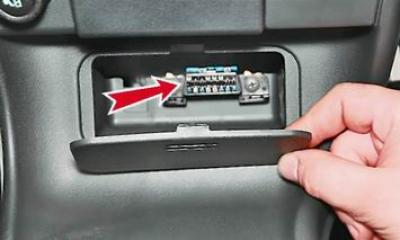During operation, the ECU monitors the health of all elements and circuits of the engine management system. Having detected a malfunction, the ECU puts the engine management system into standby mode and turns on the engine malfunction indicator lamp located on the instrument panel. The engine will then be able to continue running (except in the case of a malfunction of the crankshaft position sensor), which allows you to get to the place of repair on your own. The ECU writes the codes of the detected faults to the RAM (RAM).
To read fault codes, it is necessary to connect an external diagnostic device to the engine management system, for example, DST-2M. To do this, the system has a diagnostic connector, the connecting block of which is installed at the bottom of the center console on the instrument panel. Access to the block is closed by a decorative cover.

You can read fault codes at a service center with the necessary equipment.
When maintaining and repairing the engine control system, the following precautions must be observed:
- Do not touch the ECU terminals with your hands. The microprocessor engine control system, the electronic components of the ECU may be damaged by electrostatic discharge.
- Getting Started with Car Repair (especially if the operations are related to the dismantling of elements of the engine control system), disconnect the terminal from the negative battery terminal.
When the battery is disconnected from the vehicle's network, fault codes will be deleted from the computer's memory.
In many cases, to check the elements of the engine control system, it is necessary to have a supply voltage in the electrical circuit of the system. At the same time, it is allowed to disconnect the wire blocks from the sensors and actuating elements of the engine control system only after the ignition is turned off.
Disconnect the wiring harness block from the computer only after removing the terminal from the negative battery terminal.
If you need to connect the battery to the car's electrical network during repairs, first make sure that the disconnected wires (terminal blocks, wire ends) do not close on "mass" and that the ignition is off. Connect the battery positive terminal first and then the negative terminal. Switch on the ignition only for the duration of the measurements.
The engine management system uses electronic components, the supply voltage of which is 5 V. Supplying voltage to them from the vehicle's electrical network (voltage in which more than 12 V) will damage the engine control system.
To check the engine control system, use a multimeter; the internal resistance of the device in voltmeter mode must be at least 10 MΩ. If necessary, to check the 12 V power supply circuits, you can use a test lamp, but the lamp power must be less than 4 W (a control lamp for the instrument panel A 12-1.2-1 power of 1.2 W or a cigarette lighter lamp AMN 12-3-1 - 3 W is suitable).
Before starting the engine, make sure that the terminals are securely fastened to the battery terminals.
To avoid failure of the electronic components of the ECU, do not disconnect the wire terminals from the battery terminals while the engine is running.
Note: Checking the condition of the elements of the engine control system is shown later in the relevant sections of the chapter "Engine management system".
